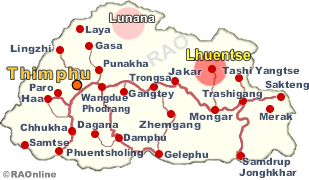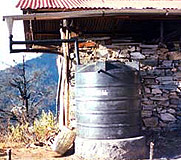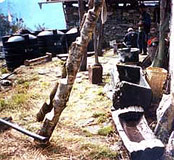 |
Bhutan Development |
|
 |
Bhutan Information |
|
|
 |
| Development Assistance in Bhutan |
 |
| Lhuentse:
Rainwater Harvesting |
 |
 |
| Perched
high on a steep hill, the Rinchen Bumpa Lhakhang in Kurtoe, Lhuentse,
is a well known pilgrimage site in eastern Bhutan. Between October and
March every year, after the harvest, pilgrims make the steep climb to the
lhakhang where they stay up to one week, seeking the blessings of the Guru
nye. But the lhakhang has been plagued by a scarcity of water. The nearest
freshwater source is a one-hour walk downhill and pilgrims spend much of
their time ferrying water for cooking and drinking. Not anymore. |
|
A simple and flexible method of harvesting rainwater has ensured that water
will now be available at the lhakhang throughout the year. Gutters have
been fitted under the eaves of the lhakhang, channeling rainwater
to a pipe which fills seven plastic water tanks that can hold 11,000 litres
of water supplying the main lhakhang, the kitchen and the guesthouse.
The system will catch rainwater during the monsoon months, April to September,
and store it in the tanks to be used by the pilgrims who visit the lhakhang
in late autumn and winter when the rains stop.
 |
Gutters channeled into the tank to store rainwater
| The
project is a joint effort of SNV, Netherlands, and the government. "The
proposal came to us from the district engineer who asked for something
which is simple but effective to solve the water crisis in the Lhakhang,"
said the SNV consultant, Mr Stephen Petersen. "We opted for the
rainwater harvesting method to solve the problem." A simple, cost-effective
and easy method, rainwater harvesting is a worldwide practice in places
where conventional water supply systems are not available. |
|
Aluminum
gutters are constructed under the eaves of the corrugated iron roofs and
connected to a pipe. The clean water is captured from the roof and saved
in containers where it is collected for future use.
top
|
Dutch
support
|
 |
 |
Traditional waa (forefront) replaced by modern tanks (background)
| Mr
Petersen said that water crisis was a pattern in such settlements. "The
houses are situated on top of mountains and ridges which makes the conventional
method of water supply difficult and very expensive to draw through pipelines."
He also pointed out that the old traditional method of collecting rainwater
in a waa (wooden tub) was unsafe because of organic materials that contaminate
it. But with this new method, if the water is covered and stored, it can
last for long period of time. |
|
"
Mr Petersen added that it was a misconception that old water was unsafe
for drinking. "In fact, the older the water the safer for drinking because
it purifies itself into distilled water which can be used even years later,"
said Mr Petersen. "But you have to make sure that it is covered well, preventing
foreign bodies entering into it."
The
rainwater harvesting project is expected to be extended to other parts
of the country, with Kengkhar and Jurmi geogs in Mongar district, selected
as the second region for promoting the practice.
| Contributed
by
Karma Choden, KUENSEL, Bhutan's National Newspaper, 2009 |
 |
top
| Links |
 |
 |
 |
External
links |

|
Netherlands
Development Organisation
SNV
World |
Netherlands
Development Organisation in Bhutan
SNV
Bhutan |
|
|
 |
| Information on Bhutan |
 |
|






